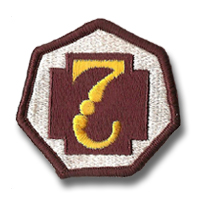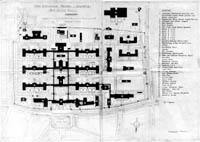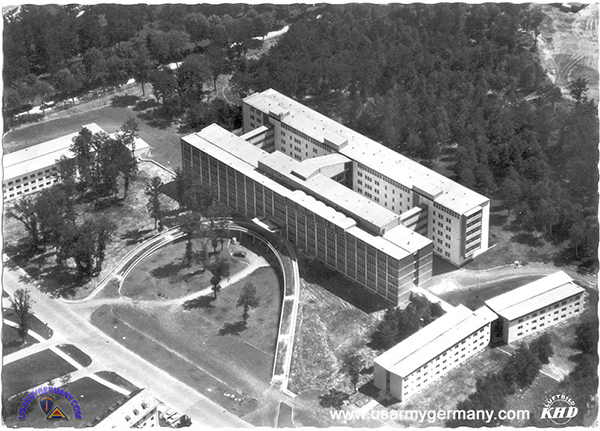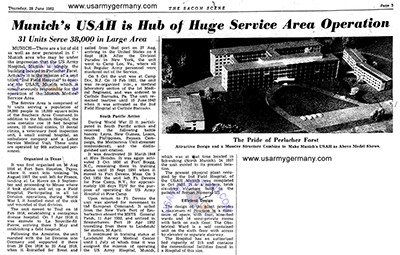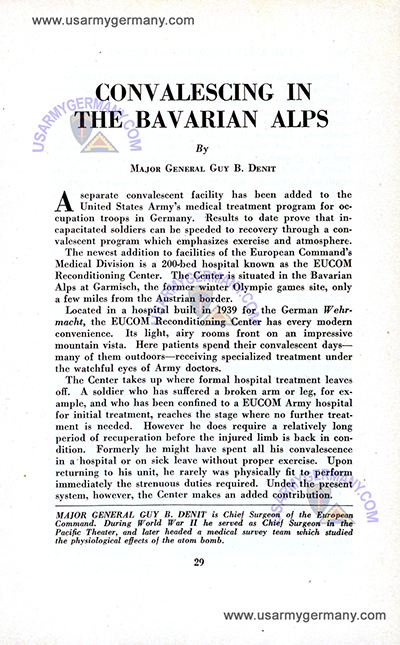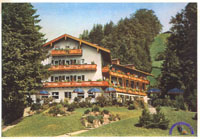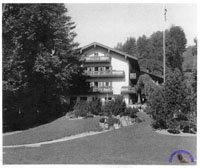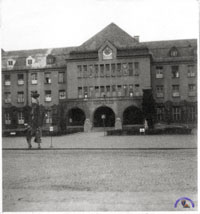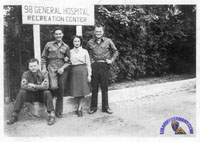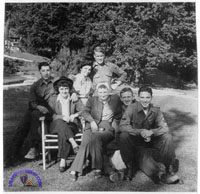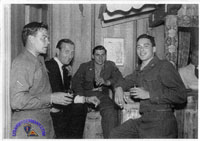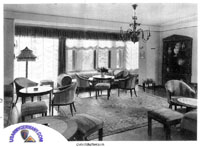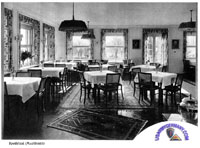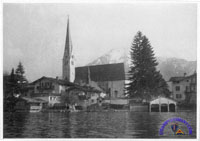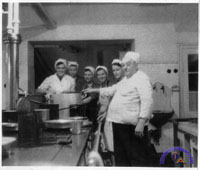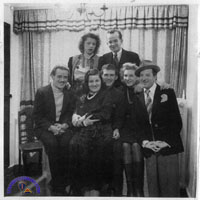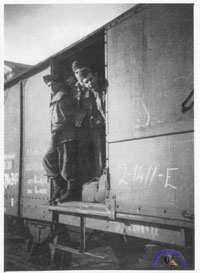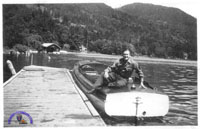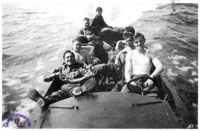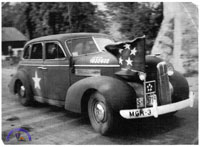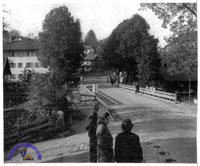| If you do
NOT see the Table of Contents frame to the left of this page, then
Click here to open 'USArmyGermany' frameset |
|||
|
U.S. Army Hospital
Munich |
|||
|
|
|||
|
|||
|
|
|||
| USAH Munich History | |||
|
98th General Hospital, Munich, Germany
|
|||
| (Source: Our Army Hospitals Series, Medical Bulletin, Sept 1946, Office of Theater Chief Surgean) | |||
| The 98th General Hospital officially opened for the reception of patients on 21 July 1945, in the former "Krankenhaus Schwabing" on the northern outskirts of the city of Munich, Germany. The unit was activated in the United States, and had been set up in the United Kingdom for seven months prior to its arrival on the continent.
The hospital is located in a 45-acre park completely surrounded by a high wall. The buildings consist of the Administration Building -- also housing two chapels and the Roman Catholic Convent of nursing sisters of the Order of the Sisters of Mercy, who formerly operated the hospital for the city of Munich -- and seven three-story ward buildings, connected by long corridors which are enclosed and heated. Between the corridors are located the large clinic buildings, the operating room, X-ray, physiotherapy, main kitchen, and mess hall. In addition, there are approximately 15 other large buildings utilized as barracks for enlisted personnel, laboratory, laundry, utilities, heating plant, and motor shed. The entire area has been landscaped, and there are flower and vegetable gardens, smooth grassy lawns, and hundreds of old shade and fruit trees. |
|||
|
|||
| The 98th operates an unusual feature unique in this Theater -- a convalescent rest and recreation center on the shores of Tegernsee, a lake resort 54 kilometers southeast of the city in the Bavarian Alps. A selected group of convalescent patients arrives each Monday at the Hotel Seeheim, one of the better tourist and resort hotels on the lake, Here they enjoy five days of fishing, swimming, sailing, boating, outdoor sports, and relaxation in the warm Alpine sunshine, A medical officer, nurse, and specially trained house-keeping staff are in attendance at all times. The ration, prenared by a Prench chef, served in an attractive dining room with an unobstructed view of the lake and mountains, and with an orchestra playing softly in the background, is a feature which never fails to elicit unbounded enthusiasm. Patients are returned to the hospital on Saturday, and over the weekend duty personnel of the unit use all facilities of the center. Saturday night dances are held, alternating between enlisted and commissioned personnel. This resort, in its beautiful lake and mountain setting, has proved itself of inestimable value in the rest and rehabilitation of patients, and is a morale builder for all personnel of the hospital. In addition to the rest center, recreation facilities provided by the hospital include one of the largest Red Cross set ups in the Theater. It occupies almost a complete floor, and is equipped with games, music, writing rooms, craft shops, and a Little Theater. The soda fountain which adjoins, operated by the Post Exchange, also is a morale builder. For personnel of the hospital, there are tennis courts and a large outdoor swimming pool. Munich itself, with its background of Nazism, offers numerous points of interest for sightseers. Conducted tours of the city are sponsored by Special Services and the Red Cross. Personnel also have access to Dachau, Berchtesgaden, Garmisch-Partenkirchen, Nurnberg, Salzburg, and other world famous places. During its twelve months of operation, the hospital admitted a total of 13,825 patients. Of these, 1,990 have been returned to the Zone of the Interior for further hospitalization, 81 have been transferred to other hospitals in this Theater, and there have been 144 deaths. The remainder have been returned to duty. The average daily patient load is from 700 to 850. The highest census was on 14 September 1948, when 1,037 patients were on the Morning Report. The patient strength gives only a faint idea of the amount of professional work provided by the 98th. Specialists serve as consultants for many of the smaller hospitals in the vicinity. Over 2,000 outpatients are seen each month. The laboratory serves nearby smaller hospitals, performing procedures which are not practical in smaller institutions. Situated in one of the most beautiful sections of Germany not far from the Ravarian Alps, the 98th has accomplished its mission with credit during the past year, and looks forward to continued service to the Army and the civilian dependents, with the purpose of continuing to offer the very test professional care that can be secured in Europe. |
|||
| 2nd Field Hospital, Munich, Germany | |||
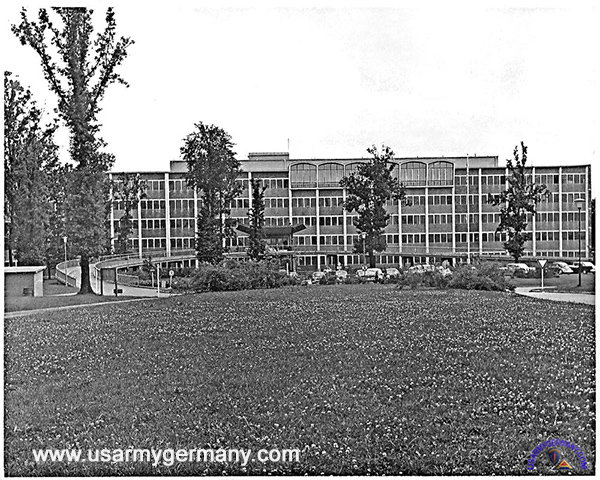 2nd Field Hospital, Perlacher Forst, Munich |
|||
| 1955 | |||
| Perlacher Forst Housing Area January 1955: Construction of the Family Housing Area in Perlacher Forst is almost completed. 67 three-story apartment buildings have been built to house the families of US soldiers stationed in and around Munich. Included in the construction project is a new hospital that will replace the current hospital (the Schwabinger Krankenhaus - 2nd Field Hospital) in Schwabing that was confiscated by US Forces in 1945 and has served as the military hospital for the Munich area since. Construction starts in May and will last about two years. Once the new hospital has been put into operation, US Forces will return the Schwabinger Krankenhaus to the German government |
|||
| (Source: STARS & STRIPES, March 7, 1955) | |||
| Plans have been approved and ground will be broken about May 1 for the new U.S. Army hospital to be built in the Perlacher Forest section of Munich, Southern Area Command Hq announced.
The 300-bed hospital will be constructed under the alternate housing program with mark funds at an approximate cost of 12,000,000 marks, of which the German Federal Republic has allocated 11,000,000 marks and the Army 1,000,000 marks. In addition, the Army will install "the most modern equipment available" at an estimated cost of 503,000 marks. The hospital area of 42,500 square yards, now undeveloped, adjoins the Perlacher Forest American housing development on the south, and is in the immediate vicinity of McGraw Casern. The Munich finance construction office estimates the hospital will be completed in two years. Upon completion and acceptance of the new hospital by Army authorities, the 500-bed 2d Field Hosp, in the Schwabing section of Munich, will be turned back to German authorities. The new five-story main hospital building will be of reinforced concrete and glass brick. It will be H-shaped, with three connecting wings. Adjacent will be troop billets for 216 men in a three-story building. Another three-story structure will house 34 doctors and 39 nurses. In the rear of the hospital will be a motor pool section occupying an area of 7,108 square yards with a vehicle repair shop occupying 1,414 square feet. Parking lots will accommodate 160 cars. Incorporated in the hospital will be a dispensary and complete dental facilities. The location will make it readily accessible to most Americans residing in the Munich area. Its location also is suitable for air evacuation of patients from Neubiberg Air Base or rail evacuation by a spur line running from the hospital area. The hospital will maintain a medical supply center and will service more than 40 smaller medical stations, the SACom announcement said. In addition to elevator service in the main building, hospital's kitchen and dining facilities will be of "the most modern design." |
|||
| If you have more
information on the history or organization of the 2nd Field Hosp/USAH
Munich, please contact me |
|||
| (Source: STARS & STRIPES, March 10, 1958) | |||
| The 300-bed 2nd Field Hospital in Munich opened in October 1957. | |||
| 1958 | |||
| (Source: SACOM Scene, May 16, 1958) | |||
| US Army Hospital Munich instituted a fixed-wing air evacuation service in 1958 in which a U-1A OTTER of the 3rd Aviation Company in Illesheim transported ambulance or litter patients from several outlying dispensaries to the Munich hospital. For more details click here to read the entire article. If anyone has additional information or photos of the fixed-wing or chopper air evac service at Munich or any other US Army hospital in Germany, please contact the webmaster. |
|||
| 1962 | |||
| 1963 | |||
| (Source: Email from Jack Elder) | |||
| I was station in Munich 1963-64-65. Was TDY to Garmisch for 14 months.
The Preventive Medicine Section inspected facilities in Gamisch district including Oberammergau and Murnau. While in Munich we were responsible for Southern Bavarian district -- Bad Aibling, Bad Tolz, Chiemsee and Berchtesgaden. I arrived in Munich December 1963. The 2nd Field Hosp was called the 225th Field Hospital. Primary duty of the hospital was a regional facility for the southern Bavaria district. The secondary mission was to act as a field hospital in the event of a combat situation. Once a year we set up as a field hospital for about 24 hours and once a year we loaded up and drove to a location in south western France, our fall back position if the Eastern Block invaded. The hospital was also responsible for Dispensaries in Garmisch, Oberammergau and Berchtesgaden. I was in the Preventive Medicine Section and we conducted Sanitary and Readiness inspections of mess halls, barber shops, beauty shops, hotels, restaurants, water treatment systems on a monthly basis. I was assigned to Garmisch at the 12th Gen Disp from March 1964 to July 1965 then returned to Munich till I was discharged in Europe. I stayed in Europe to travel for about 6 six months then I wintered in Berchtesgaden where I tended bar in the EM Club nights and trained at the sled track in Koniggssee. I left B'Gaden in the spring of 1967 and returned to the U.S. In November 1969 I returned with my family to B'Gaden and spent another winter tending bar and training. I did do a lot of B/W photography in Garmisch as we had a hobby lab in Murnau. Been years since I looked at the neg's but hope to get started soon on the transferring to computer format. |
|||
|
|
|||
| EUCOM Medical Reconditioning Center (Garmisch) | |||
 MEMBERS OF THE STAFF: left to right, 1st Lt Melvin F. Deland, MSC; 1st Lt Eithel Smith, MSC; Major John E. Street, MSC; mess officer, Lt Col Cecil G. Stillinger, MC; Capt David C. Guarnieri, MSC, 1st Lt Willard C. Friz, MSC. Members of the staff not shown are Col John F. Bohlender, LTC, and Charles Lynch, D/A Civilian |
|||
| (Source: EUCOM Medical Bulletin, September 1949) | |||
An Annex of the 98th General Hospital, Munich, the EUCOM
Medical Reconditioning Center was activated recently at Garmisch, Germany, with Lt Col Cecil G. Stillinger, MC, in direct charge as Deputy to Col John F. Bohlender, MC, CO of the 98th. Officials at the center are imbued with only one aim -- to restore soldiers to full physical fitness for their duties.
To this end, a graduated reconditioning program is carried out under the immediate supervision of three reconditioning officers who have had extensive experience in this field -- 1st Lt Willard C. Friz, MSC, 1st Lt Melvin F. Deland, MSC, 1st Lt Eithel G. Smith, MSC -- and Charles Lynch, a Department of the Army civilian who is an expert on winter sports and mountain climbing. Reconditioning exercises and games, from shuffleboard to the toughest of commando exercises, are fitted to the patient's individual needs. A soldier with a broken back, for example, is taught archery. The pull of the 45 pound bow along with other exercises tones up back muscles so that the soldier can resume his Army duties almost as soon as the cast is taken off. Soldiers with broken arms play tetherball, a game that allows the exercise of all but the broken limbs. There's a game even for patients with broken legs -- volleyball played from a sitting position. This again allows streneous exercise of all but the splitted parts. After two or three weeks, the patient is returned to his home hospital where the splint is,removed. He is then sent back to the center where he takes a week or two of special corrective exercises for the injury. Hiking, always an Army favorite in any reconditioning program, is not left out of the picture. But hiking at the center is not the disgrunted drill of dispirited troops so familiar in basic training. Instead of drill, as such, the soldier goes mountain climbing. Each day, as his strength returns, he gets further up the beautiful mountain side, which serves as a graphic portrayal of his physical gains. Probably the most gruelling exercise in the reconditioning program, the convalescent soldier is enthusiastic about this new form of hiking. He looks forward to the day he is allowed to conquer the mountain top. As most of the staff at the center are graduates of the physical reconditioning program of the University of Washington and Lee, Lexington, Va., the center's program is based largely on Dr. A. Thorndike's reconditioning theories. The man who did so much during the war to lop off the Army's pot bellies with his classes at Washington and Lee, Dr. Thorndike, formerly Chief of Reconditioning of the US Army, is proof of his own theories, The doctor recently celebrated his seventieth birthday by doing seventy pushups. As much thought is given at the center to the soldier's morale welfare as to his physical conditioning. Athletic activities are carefully planned so there will be no flagging in the soldier's interest. The recreational facilities of the Garmisch Post are made available to all patients. A bus runs into town every hour. Special tours to points of interest in the surrounding countryside, like Oberammergau, the beautiful Bavarian town famous for its passion play, are planned for the weekends. Services will be held soon every Sunday in the center's own little chapel. Only two to three soldiers are billeted to most rooms. And, above all, the food is excellent. Officials feel that a great contribution to the excellent morale of the patients is the hospital and its location. Built in 1939 for Hitler's Army, the hospital has every modern convinience. It is light, airy, surrounded by beautiful grounds, with a mountain backdrop which is breathtaking in its rugged splendor. With some foresight, the Nazis painted murals throughout the hospital, depicting nude, young barbarians practicing their "strength-through-joy" lives. The murals are perfectly suitable for a recondition center, except one. This, a mural over the altar, portraits Christ as a blond Nazi superman. The Chaplain thought that this was going a bit too far, so the center is covering it up. The center will soon recondition about 200 convalescent soldiers at a time. Any EC hospital other than the 98th wishing to send convalescent soldiers to the center must notify the Hospitalization and Evacuation Section, EUCOM Medical Division, so as to be assigned spaces. The convalescents will be evacuated first to the 98th and then to the Garmisch center. Capt David C. Guarnieri, administrative officer for the center, pointed out that Medical Corps officers should keep in mind that "the center is for reconditioning and not an old soldiers rest home." |
|||
| 12th General Dispensary | |||
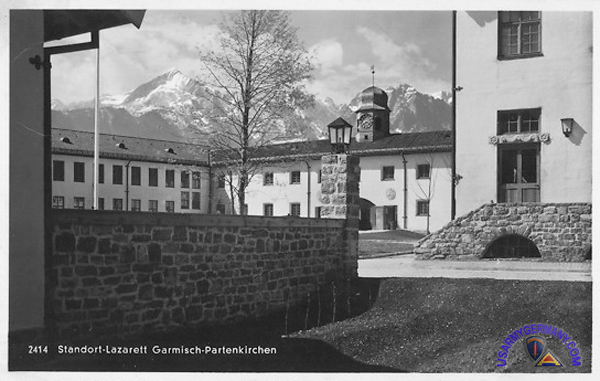 WWII postcard of the German Standort-Lazarett in Garmisch |
|||
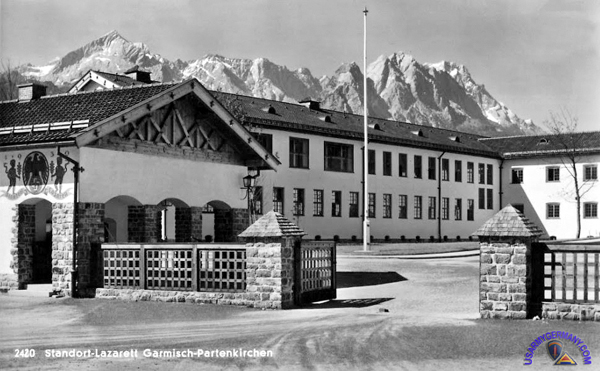 Vehicle gate, Standort-Lazarett Garmisch (undated German postcard) - the installation serves today as HQ Armed Forces Recreation Center Europe (Need photos of the dispensary during the time it was used by the US Army) |
|||
| (Source: USAREUR Medical Bulletin, April 1957) | |||
The US Army General Dispensary, Garmisch, is operated by the 12th General Dispensary. During World War II this building was occupied by the German Army and was utilized as an army hospital (Standort Lazarett) and interrogation center for captured high officials. In May 1945 this building was confiscated and occupied by the 14th Field Hospital, which was assigned there by Colonel Alvin L. Gorby, then Deputy Surgeon at Frankfurt (now Major General Corby, USAREUR Surgeon). This facility presently has an operational capacity of 24 beds and provides medical support for all assigned military personnel, their dependents, and approximately 14,000 tourist transits per month. The Commanding Officer is Captain Robert W. Minick, who is also Surgeon for the Garmisch Sub-Area. The Garmisch Sub-Area includes Garmisch, Oberammergau, Fuessen and Murnau. |
|||
| Hotel Seeheim, Tegernsee | |||
| (Source: Email from Richard Buren) | |||
| I was 18 years old on the troopship Wilson Victory plowing through mountainous seas on our way to Le Havre. We arrived on Feb.10, 1946 and walked in mud and slept in cigarette camps. Travel from there to Munich was in freight cars. Trained as infantrymen we were surprised to be assigned to 98th General Hospital (Schwabinger Krankenhaus). The Commander was Colonel Soper, a doctor who personally interviewed 30 or 40 infantry for duties in the hospital. I was sent to the R&R Department. In a couple of weeks I was told that I was going to the Hotel Seeheim in the village of Tegernsee about 45 miles away. "We'll call you in a couple of weeks," I was told. I was delighted and I could speak a little German. My equipment: a sidearm and jeep with trailer loaded with food and sundries. My orders: to stay put until an officer calls. I was the only "guest" in a fully staffed hotel. I had nothing to do but look over my balcony, sleep, eat and learn how to sail. In due time I thought that the Army forgot me so I thought that I would seek out the Army. An officer answers my call with Who? I remind him. He asks if I had requisitioned the hotel yet? No one told me to requisition it, I said. What do I have to do to requisition the hotel? The officer, annoyed, tells me to go to the Military Government to get the forms. Where can I find the Military Government? The frustrated Officer tells me to ask one of the employees. I asked Hans the hotel manager who speaks English. He says "Meisbach" The Militarregierung ist in Meisbach. I went there and got requisition forms, quite simply, filled them out and returned them. The beginning of the best damn Occupation recreation hospital in the ETO. I never took my meals in the dining room. When first I went into the dining room there was one waitress on duty waiting for the one "guest" She wore an immaculate black uniform with white apron. She smiled and said "guten abend", and I smiled and said the same. There is no way that I would let myself be the lone person in the dining room. I walked into the kitchen and met Opa and his assistant Mutti and most of the kitchen staff. I saw a sturdy table in a storeroom and pointed to it as my eating place. Opa offered me a choice of cuisine or whatever he cooked for the staff. I chose the food cooked for the staff and I had the best of it. The fact is that the smell and taste was that of my grandmothers kitchen. When I "requisitioned" the Hotel Seeheim I was a private. Colonel Soper's wife and son arrived from the states. Their apartment in Munich was not ready. One the Colonel's staff called me at the Hotel asking if I had suitable quarters for his family. I had indeed. The owners of the Hotel Seeheim were not in residence. It was on the top floor of the Hotel. Inside it was an Alpine ski lodge for a family. Mrs. Soper was delighted. Next she required having her hair done and we did that in the village of Tegernsee. There were rumors of die hard nazis in the vicinity. I wore my sidearm and stood in front of the store. The following week I made T/5. Since then my slogan in life has been "It is good to be nice to a Colonel when you are a private." Every evening a quartet would play classical music at dinner. Movies every Wednesday and every Saturday entertainment such as modest chorus girls, magicians, apache dancers, singers and maybe zither players in the large living in late afternoons. Since there was a change of audience we, would hire the same artists and acts to come back. After the show the entertainers mingled with the audience eating the same food which we felt to be part of their pay. Those were the days of scarcity. On one occasion an attractive dark haired girl sat alone at the back of the dining room. No mingle, no talk, no food. She saw a star of David around my neck. She told me that she was half Jewish, her mother all Jewish. They survived by a law called Mischlinge which protected partial Jews. Her name was Liselotte Groinger. I met her mother. The three of us went to the Prinzregenten Theater to see a performance of "TALES OF HOFFMANN" by Jacques Offenbach who was a Jew. His work was banned by the nazis. I was moved that so many Germans were standing in the bitter cold to get tickets. At the Seeheim Hotel a gathering of high ranking doctors including a General was planned. The Seeheim's rooms would be full. The festivities would be on the grounds of the Seeheim Hotel. A T Sgt. named Bill Bailey came to us from an engineering unit to design and supervise German carpenters building a portable dance floor and band stand. In the kitchen Opa, the chef, and Ms Harper the dietician for the 98th General Hospital were in charge. The R&R department in Munich was making arrangements for special entertainers including a dancer in a transparent gown. The music came from the SS dance band that was interned in Dachau and guarded for this occasion by Polish soldiers carrying thomson submachine guns. The music from the SS dance band was as good as any of the big bands in the U.S. As for me the entire scene was incredible. There was all that brass in their best uniform and those women in their cocktail dresses (at 19 years I was smart enough not to ask who the women were). The view across the Tegernsee, the church steeple and the mountains in the back, Himmler is dead but his house is less than 10 miles away in Gmund, High ranking United States officers dancing to SS musicians and Richard Burenstein T/5 from south Philadelphia taking it all in. Thinking that he would never be believed. I lived in Zimmer 12 for 10 months in the Pension Seeheim, Thea Greither, Tegernsee - Fernruf: 4286. An experience that I am remembering into my dotage. |
|||
| Related Links: |
|||
